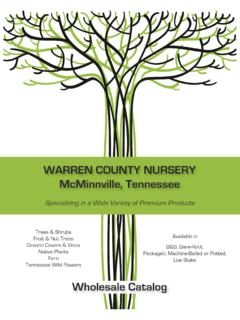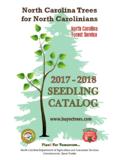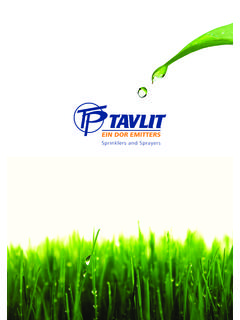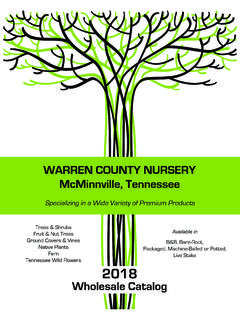Transcription of Tree Seedling Catalog - ottawacd.org
1 tree Seedling Catalog 2018 Annual tree Seedling Sale Order Deadline: Friday, April 6, 2018. Sale and Order Pick-Up: Friday, April 20, 2018, 1:00 PM - 6:00 PM. Reenders Blueberry Farm: 9981 West Olive Rd, West Olive, MI 49460. Tips for Using this Catalog Symbols are used to indicate if the Seedling is a conifer/evergreen tree , deciduous tree , shrub, or grass (Scientific names) Scientific names included with descriptions are provided to make it easier to look up information about the specific trees and shrubs in this Catalog Pictures of many of the trees in this Catalog can be found on the Ottawa Conservation District website at , or search online using the common and scientific names for the most accurate information Conifer (Evergreen) Trees Colorado Blue Spruce (Picea pungens)
2 * Concolor Fir (Abies concolor)*. Native to Colorado, this spruce adapts well to Native to western North America, this tree , also most growing conditions. It prefers full sun. known as white fir, does well in a variety of Because of its dense branch structure, birds and growing conditions. The seeds (inside the other small wildlife use Colorado Blue Spruce a cones) provide food for birds and small for winter shelter and nesting. Colorado Blue mammals. Concolor Fir is grown most often for Spruce is grown for landscaping, Christmas Christmas trees. It is also used for landscaping trees, and wildlife.
3 Slow growing, long-lived, and can be a relatively successful windbreak grows to 40-60', Seedling size: 9-15 tree . Moderately fast growing, grows to 30-50', Seedling size: 8-14 . Note: * Indicates species that are not native to the Midwest region 1. Eastern Red Cedar (Juniperus virginiana) White Cedar (Thuja occidentalis). The Eastern Red Cedar is well established in dry The White Cedar is also called Arborvitae. It soils and is resistant to extremes of drought, prefers full sun, but will tolerate some shade. heat, and cold. The berries are consumed by a Ideal soil conditions are wet/moist, poorly- variety of wildlife.
4 The dense, scalelike branches drained sites, but it can handle most soil also offer protection and nesting sites for song conditions. Because of the dense structure of its sparrows, robins, and mockingbirds. It can be foliage, White Cedar is a source of cover and grown on clay, loam, or sand. Moderately fast windbreak for songbirds and wildlife. Protect growing, can be long-lived, grows to 40-60', young trees from deer. Slow growing, can be Seedling size: 10-16 long-lived, grows to 30-50', Seedling size: 18-24 . Jack Pine (Pinus banksiana) White Pine (Pinus strobus). Jack Pine is an open-crowned tree with The White Pine is the State tree of Michigan.
5 Spreading branches and stout needles. This tree This pine thrives in moist, well-drained soil and does well in dry, sandy soils or mineral beds. full sun to partial shade. The seeds (inside the The pine cones are serotinous, meaning they cones) provide food for small wildlife and open under extreme heat associated with songbirds. White pine is grown for timber, wildfire. This tree serves as an important wildlife cover, landscapes and windbreaks. habitat for the Kirtland's warbler, a rare Moderately fast growing, can be long-lived, songbird. Jack Pines prefer full sun. Fast grows to 80-100', Seedling size: 6-12.
6 Growing, can be long-lived, grows to 30-70', Seedling size: 10-18 . Norway Spruce (Picea abies)* White Spruce (Picea glauca). Native to Europe, the Norway Spruce provides The White Spruce has rows of horizontal winter cover for birds and other small wildlife. It branches that form a conical crown. This tree prefers full sun, but can be shade tolerant. It is prefers moist to well-drained soil. Seedling tolerant of many soil types, preferring acidic, establishment is best in full sun, but they are loamy, moist, sandy and well-drained soils. capable of growing in shaded understory.
7 Norway Spruce is grown for wildlife cover, Various kinds of wildlife, including deer, rabbits, landscapes, and wind cover. Moderately fast and grouse, browse spruce foliage in the winter. growing, can be long-lived, grows to 50-85', Slow to moderately slow growing, can be long- Seedling size: 9-15 lived, grows 40-100', Seedling size: 12-18 . Red Pine (Pinus resinosa). Red Pine is a fast growing, shade-intolerant pine tree . The seeds (inside the cones) provide food for small wildlife and songbirds. Since it is fast growing and produces long, straight trunks, it has often been used for pine plantations.
8 Fast growing, can be long-lived, grows to 65-100', Seedling size: 6-14 . Note: * Indicates species that are not native to the Midwest region 2. Deciduous Trees Quaking Aspen (Populus tremuloides) White Oak (Quercus alba). Quaking aspen provides forage and nesting for White Oak was an important lumber source for birds and mammals. It also serves as a host shipbuilding, and continues to be grown for plant for insects that provide food for high-quality lumber. It grows less quickly than woodpeckers and sapsuckers. Quaking aspens the Red Oak, prefers full sun and moderately- to do best in full sun and prefer abundant well-drained soil.
9 The acorns provide a food moisture and well-drained soil. Fast growing, source for wildlife. Relatively slow growing, grows to 50-110', Seedling size: 18-24 grows to 50-80', Seedling size: 12-18 . Red Oak (Quercus rubra) Sugar Maple (Acer saccharum). Red oak is a shade tree that transplants easily This tree offers colorful autumn foliage in a and grows quickly. It produces acorns that offer landscape and the seeds are especially favored a food source for wildlife. Red Oak does best in by squirrels. Sugar Maples prefer full sun or well-drained soil, moderately moist to dry partial shade and grow well on moist, well- conditions, and full sun.
10 Fast growing, grows to drained soil. It is used in landscaping, grown for 65-100+', Seedling size: 12-18 timber, and for maple syrup. Slow to moderately slow growing, grows to 80-100', Seedling size: 12-18 . Shrubs and Small Trees Common Lilac (Syringa vulgaris)* Holly Winterberry (Ilex verticillata). This large shrub, native to Europe, provides Holly, or Common, Winterberry has bright red clusters of blooms, nectar and pollen for berries that attract a large spread of mammals and pollinators, and nesting habitat for songbirds. birds (although good for wildlife, these berries are Common Lilac is pleasantly aromatic, blooming in poisonous to humans).




